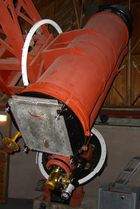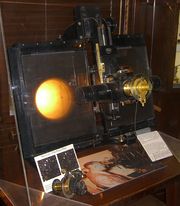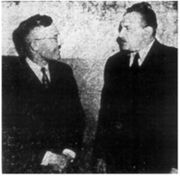Clyde Tombaugh
| Clyde William Tombaugh | |
|---|---|
| Born | February 4, 1906 Streator, Illinois |
| Died | January 17, 1997 (aged 90) Las Cruces, New Mexico |
| Nationality | American |
| Occupation | Astronomer |
| Known for | Discovery of Pluto |
Clyde William Tombaugh (February 4, 1906 – January 17, 1997) was an American astronomer.
Tombaugh is best known for discovering the dwarf planet Pluto in 1930, but also discovered many asteroids, and called for serious scientific research of unidentified flying objects.
Contents |
Biography
Tombaugh was born in Streator[1], LaSalle County, Illinois.
After his family moved to Burdett, Kansas, Tombaugh's plans for attending college were frustrated when a hailstorm ruined their crops.[2] Starting in 1926, he built several telescopes with lenses and mirrors he ground himself.[2] He sent drawings of Jupiter, Mars, and his telescopes to the Lowell Observatory. These resulted in a job offer. Tombaugh was employed at the Lowell Observatory from 1929 to 1945.
Following his discovery of Pluto, Tombaugh earned bachelor's and master's degrees in astronomy from the University of Kansas in 1936 and 1938.[2] During World War II he taught naval personnel navigation at Northern Arizona University.[2] He worked at the White Sands Missile Range in the early 1950s, and taught astronomy at New Mexico State University from 1955 until his retirement in 1973. He died in Las Cruces, New Mexico, 1997 and was survived by his wife Patricia, daughter Annette and son Alden, a retired banker.[3] Tombaugh was the great-uncle of Los Angeles Dodgers pitcher Clayton Kershaw.[4]
Tombaugh was an active Unitarian-Universalist.
The asteroid 1604 Tombaugh,[5] discovered in 1931, is named after him. He himself discovered hundreds of asteroids, beginning with 2839 Annette in 1929, mostly as a by-product of his search for Pluto and his further searches for other celestial objects.[2] Tombaugh named some of them after his wife, children and grandchildren. The Royal Astronomical Society awarded him the Jackson-Gwilt Medal in 1931.
Approximately one ounce of his ashes are being carried on the New Horizons spacecraft, launched in 2006 for a flyby of Pluto in 2015. The container includes the inscription: "Interned, herein are remains of American Clyde W. Tombaugh, discoverer of Pluto and the solar system's 'third zone.' Adelle and Muron's boy, Patricia's husband, Annette and Alden's father, astronomer, teacher, punster, and friend: Clyde W. Tombaugh (1906–1997)". Since New Horizons is traveling well above the escape velocity of the Solar System, Tombaugh's remains will be the first such to reach interstellar space.[6]
Discovery of Pluto

While a young researcher working for the Lowell Observatory in Flagstaff, Arizona, Tombaugh was given the job to perform a systematic search for a trans-Neptunian planet (also called Planet X), which had been predicted by Percival Lowell and William Pickering.
Tombaugh used the observatory's 13-inch astrograph to take photographs of the same section of sky several nights apart. He then used a blink comparator to compare the different images. When he shifted between the two images, a moving object, such as a planet, would appear to jump from one position to another, while the more distant objects such as stars would appear stationary. Tombaugh noticed such a moving object in his search, near the place predicted by Lowell, and subsequent observations showed it to have an orbit beyond that of Neptune. This ruled out classification as an asteroid, and they decided this was the ninth planet that Lowell had predicted. The discovery was made on Tuesday, February 18, 1930, using images taken in January of the same year.[7]
The name "Pluto" was suggested by Venetia Burney, then an 11-year-old English school girl, who died in April 2009, and who therefore lived to see the reclassification of Pluto as a dwarf planet. It won out over numerous other suggestions partly because it was named after the Roman god of the underworld because he was able to render himself invisible and because Percival Lowell's initials PL formed the first 2 letters. The name Pluto was officially adopted on 1 May 1930.

Following the discovery of the Kuiper belt objects starting in the 1990s, Pluto began to be seen not as a planet orbiting alone at 40 AU, but as the largest of a group of icy bodies in that region of space. After it was shown that at least one such body was larger than Pluto, on August 24, 2006 the International Astronomical Union (IAU) reclassified Pluto, grouping it with two similarly sized "dwarf planets" rather than with the eight "classical planets".
Tombaugh's widow Patricia stated after the IAU's decision that while Clyde may have been disappointed with the change since he had resisted attempts to remove Pluto's planetary status in his lifetime, he would have accepted the decision now if he were alive. She notes that Clyde "was a scientist. He would understand they had a real problem when they start finding several of these things flying around the place."[8]
Further search
Tombaugh continued searching for some years after the discovery of Pluto, and the lack of further discoveries left him satisfied that no other object of a comparable apparent magnitude existed near the ecliptic. No more Trans-Neptunian objects were discovered until (15760) 1992 QB1, in 1992.
However, more recently the relatively bright object Makemake has been discovered. It has a relatively high orbital inclination, but at the time of Tombaugh's discovery of Pluto, Makemake was only a few degrees from the ecliptic near the border of Taurus and Auriga[9] at an apparent magnitude of 16.[10] Unfortunately, this position was also very near the galactic equator, making it almost impossible to find such an object within the dense concentration of background stars of the Milky Way.
Asteroids discovered

Tombaugh discovered nearly 800 asteroids[11] during his search for Pluto and years of follow-up searches looking for another candidate for the postulated Planet X. Tombaugh is also credited with the discovery of comet C/1931 AN,[12] though its orbit is currently unknown. He also discovered hundreds of variable stars, as well as star clusters, galaxy clusters, and a galaxy supercluster.[2]
| Designation | Discovery |
|---|---|
| 2839 Annette | October 5, 1929 |
| 2941 Alden | December 24, 1930 |
| 3310 Patsy | October 9, 1931 |
| 3583 Burdett | October 5, 1929 |
| 3754 Kathleen | March 16, 1931 |
| 3775 Ellenbeth | October 6, 1931 |
| 3824 Brendalee | October 5, 1929 |
| 4510 Shawna | December 13, 1930 |
| 4755 Nicky | October 6, 1931 |
| 5701 Baltuck | November 3, 1929 |
| (6618) 1936 SO | September 16, 1936 |
| (7101) 1930 UX | October 17, 1930 |
| (7150) 1929 TD1 | October 11, 1929 |
| (8778) 1931 TD3 | October 10, 1931 |
Interest in UFOs
Tombaugh was probably the most eminent astronomer to have reported seeing unidentified flying objects and to support the extraterrestrial hypothesis. On August 20, 1949, Tombaugh saw several UFOs near Las Cruces, New Mexico. He described them as six to eight rectangular lights, stating:
- "I doubt that the phenomenon was any terrestrial reflection, because... nothing of the kind has ever appeared before or since... I was so unprepared for such a strange sight that I was really petrified with astonishment."[13]
A similar shocked response has been reported by many others who claim to have seen mysterious aerial objects.
Another sighting by Tombaugh a year or two later while at a White Sands observatory was of an object of −6 magnitude, four times brighter than Venus at its brightest, going from the zenith to the southern horizon in about 3 seconds. The object executed the same maneuvers as in Tombaugh's first sighting.[14]
Tombaugh was also later to report having seen three of the mysterious green fireballs, which suddenly appeared over New Mexico in late 1948 and continued at least through the early 1950s. Despite this, the final report of Project Twinkle — see external link — claimed that he "... never observed an unexplainable aerial object despite his continuous and extensive observations of the sky."
In 1956 Tombaugh had the following to say about his various sightings:
- "I have seen three objects in the last seven years which defied any explanation of known phenomenon, such as Venus, atmospheric optic, meteors or planes. I am a professional, highly skilled, professional astronomer. In addition I have seen three green fireballs which were unusual in behavior from normal green fireballs ... I think that several reputable scientists are being unscientific in refusing to entertain the possibility of extraterrestrial origin and nature."[15]
Shortly after this in January 1957, in an Associated Press article in the Alamogordo Daily News titled "Celestial Visitors May Be Invading Earth's Atmosphere," Tombaugh was again quoted on his sightings and opinion about them.
- "Although our own solar system is believed to support no other life than on Earth, other stars in the galaxy may have hundreds of thousands of habitable worlds. Races on these worlds may have been able to utilize the tremendous amounts of power required to bridge the space between the stars..."
Tombaugh said he has observed celestial phenomena which he could not explain, but has seen none personally since 1951 or 1952. "These things, which do appear to be directed, are unlike any other phenomena I ever observed. Their apparent lack of obedience to the ordinary laws of celestial motion gives credence."[16]
In 1949, Tombaugh had also told the Naval missile director at White Sands Missile Range, Commander Robert McLaughlin, that he had seen a bright flash on Mars in August 1941, which he now attributed to an atomic blast.[17] Tombaugh also noted that the first atomic bomb tested in New Mexico would have lit up the dark side of the Earth like a neon sign and that Mars was coincidentally quite close at the time, the implication apparently being that the atomic test would have been visible from Mars.
In June 1952, Dr. J. Allen Hynek, an astronomer acting as a scientific consultant to the Air Force's Project Blue Book UFO study, secretly conducted a survey of fellow astronomers on UFO sightings and attitudes while attending an astronomy convention. Tombaugh and four other astronomers, including Dr. Lincoln LaPaz of the University of New Mexico, told Hynek about their sightings. Tombaugh also told Hynek that his telescopes were at the Air Force's disposal for taking photos of UFOs, if he was properly alerted.[18]
Near-Earth satellite search

Tombaugh's offer may have led to his involvement in a search for near-Earth satellites, first announced in late 1953 and sponsored by the Army Office of Ordnance Research. Another public statement was made on the search in March 1954 (photo at right), emphasizing the rationale that such an orbiting object would serve as a natural space station.[19] However, according to Donald Keyhoe, later director of the National Investigations Committee on Aerial Phenomena (NICAP), the real reason for the sudden search was because two near-Earth orbiting objects had been picked up on new long-range radar in the summer of 1953, according to his Pentagon source.
By May 1954, Keyhoe was making public statements that his sources told him the search had indeed been successful, and either one or two objects had been found.[20] However, the story didn't really break until August 23, 1954, when Aviation Week magazine stated that two satellites had been found only 400 and 600 miles out. They were termed "natural satellites" and implied that they had been recently captured, despite this being a virtual impossibility. The next day, the story was in many major newspapers. Dr. LaPaz was implicated in the discovery in addition to Tombaugh. LaPaz had earlier conducted secret investigations on behalf of the Air Force on the green fireballs and other unidentified aerial phenomena over New Mexico.
LaPaz vehemently denied his involvement in the search, although the New York Times reported on August 29 that a source close to the project said that the story was true and LaPaz was indeed involved, in fact had been the one to spot and identify the objects as natural rather than artificial satellites. The same source denied the search had anything to do with flying saucers.[21]
However, both LaPaz and Tombaugh were to issue public denials that anything had been found. The October 1955 issue of Popular Mechanics magazine reported:
- "Professor Tombaugh is closemouthed about his results. He won't say whether or not any small natural satellites have been discovered. He does say, however, that newspaper reports of 18 months ago announcing the discovery of natural satellites at 400 and 600 miles out are not correct. He adds that there is no connection between the search program and the reports of so-called flying saucers."[22]
At a meteor conference in Los Angeles in 1957, Tombaugh reiterated that his four year search for "natural satellites" had been unsuccessful.[23] In 1959, Tombaugh was to issue a final report stating that nothing had been found in his search.
Personal
His personal 16-inch telescope was reassembled and dedicated on September 17, 2009 at Rancho Hidalgo, New Mexico (near Animas), adjacent to Astronomy 's new observatory.[24] His great-nephew is Los Angeles Dodgers starting pitcher Clayton Kershaw.
References
- ↑ Tombaugh, Clyde; Patrick Moore (1980). Out of the Darkness: The Planet Pluto. Harrisburg, PA: Stackpole Books. pp. 17. ISBN 0811711633. "I was born on a farm near Streator, Illinois, on 4 February 1906."
- ↑ 2.0 2.1 2.2 2.3 2.4 2.5 "A Man of Universal Wonder". Academy of Achievement. American Academy of Achievement. 2006-09-09. http://www.achievement.org/autodoc/page/tom0bio-1. Retrieved 2010-04-25.
- ↑ Hill, Karl (Summer 2001). "Tombaugh Family Donates Astronomer's Papers to NMSU". Panorama. http://www.nmsu.edu/~ucomm/Panorama/summer2001/path.html. Retrieved 2007-02-28.
- ↑ Kershaw, Clayton (2009-12-22). "Chat with Clayton Kershaw". ESPN.com. http://espn.go.com/los-angeles/chat/_/id/30042/dodgers-clayton-kershaw. Retrieved 2009-12-22.
- ↑ "(1604) Tombaugh". Asteroid Dynamic Site. http://hamilton.dm.unipi.it/cgi-bin/astdys/astibo?objects:Tombaugh;main. Retrieved 2007-02-28.
- ↑ Buckley, M.; Alan Stern (2006-02-03). "Happy 100th Birthday, Clyde Tombaugh". JHU Applied Physics Laboratory. http://www.jhuapl.edu/newscenter/pressreleases/2006/060203.asp. Retrieved 2009-05-19. Presumably interred was the word intended.
- ↑ Kansas State Historical Society, 'Clyde Tombaugh'
- ↑ Associated Press (2006-08-25). "Pluto Discoverer Saw It Coming, Says His Widow". CTV. http://www.ctv.ca/servlet/ArticleNews/story/CTVNews/20060825/pluto_discoverer_widow_060825/20060825?hub=SciTech. Retrieved 2007-02-28.
- ↑ based on Minor Planet Center online Minor Planet Ephemeris Service: March 1, 1930: RA: 05h51m, Dec: +29.0
- ↑ "HORIZONS Web-Interface". JPL Solar System Dynamics. http://ssd.jpl.nasa.gov/horizons.cgi?find_body=1&body_group=sb&sstr=2005FY9. Retrieved 2008-07-01.
- ↑ Darling, David. "Tombaugh, Clyde William (1906-1997)". The Internet Encyclopedia of Science. http://www.daviddarling.info/encyclopedia/T/Tombaugh.html. Retrieved 2010-04-25.
- ↑ Levy, David (2003). David Levy's Guide to Observing and Discovering Comets. Cambridge University Press. ISBN 0521520517. http://books.google.com/?id=2AzBYCYV9ucC&pg=PA79&lpg=PA79&dq=Tombaugh+comet.
- ↑ "Clyde Tombaugh, Ph.D.". UFO Evidence. http://www.etcontact.net/researchers/detail107.htm. Retrieved 2007-02-28.
- ↑ Steiger, Brad (1976). Project Blue Book. Ballantine Books. p. 280. ISBN 0-345-34525-8.
- ↑ Ledger, Don (2004-09-20). "UFO UpDates". http://virtuallystrange.net/ufo/updates/2004/sep/m20-022.shtml. Retrieved 2007-02-28.
- ↑ Clark, Jerry (1997). UFO Encyclopedia: Volume 2. p. 896.
- ↑ McLaughlin, Robert (1949-05-12). "Letter from Robert McLaughlin to James van Allen". Roswell Proof. http://www.roswellproof.com/McLaughlin_Van_Allen_letter.html. Retrieved 2007-02-28.
- ↑ Steiger, Brad (1976). Project Blue Book. Ballantine Books. pp. 268–285. ISBN 0-345-34525-8.
- ↑ "Armed Forces Seeks "Steppingstone to Stars"". Los Angeles Times. 1954-03-04. http://www.roswellproof.com/Satellites_LATimes_SciNL_1954.html.
- ↑ "1 or 2 Artificial Satellites Circling Earth, Says Expert". San Francisco Examiner: pp. 14. 1954-05-14. http://www.roswellproof.com/Satellites_Keyhoe_May1954.html.
- ↑ "Earth 'Satellites' Spur Army Study". New York Times: pp. 35. 1954-08-29. http://www.roswellproof.com/Satellites_NYTIMES_1954.html.
- ↑ Stimson, Jr., Thomas E. (October 1955). "He Spies on Satellites". Popular Mechanics: pp. 106. http://www.roswellproof.com/Satellites_PopMech_Oct55.html.
- ↑ Los Angeles Times. 1957-09-04.
- ↑ David J. Eicher (January 2010). Astronomy ("Editors dedicate Astronomy 's new observatory"). Kalmbach Publishing. p. 8.
Further reading
- Falk, Dan, "More than a one-hit wonder", Astronomy, February 2006, 40–45.
- David H. Levy Clyde Tombaugh: Discoverer of the Planet Pluto (Tucson, Ariz.: University of Arizona Press, 1991). ISBN: 0816511489; also Sky Publishing Corporation, March 2006
External links
- Many biographical articles on Clyde Tombaugh
- Quote from Tombaugh on UFOs
- UFO activities of Tombaugh
- Academic paper on Tombaugh's UFO activities and near-earth satellite search
- Final report of Project Twinkle
- Illinois proposes a Pluto Day and reinstate Pluto as a Planet in honor of C. Tombaugh: Illinois General Assembly, Senate Resolution SR0046 2/26/2009